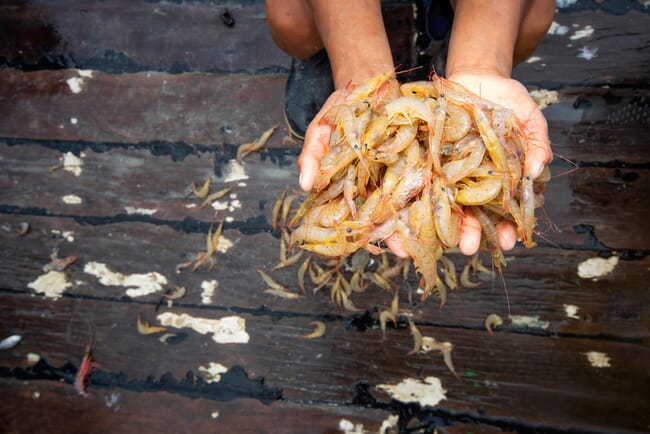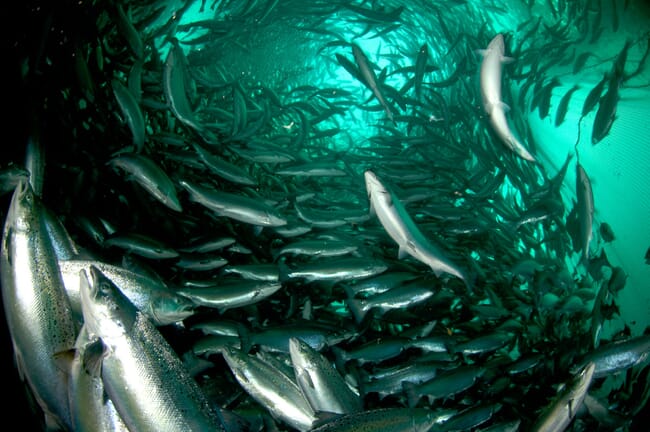
The differing characteristics of the salmon and shrimp industries have a huge bearing on the sources of their greenhouse gas emissions
Emily Moberg, lead author of the reports*, explains some of the key takeaways for aquaculture operators.
Why did you choose shrimp and salmon as the two aquaculture species to assess?
Our goal, across all the commodities, was to choose contrasting commodities—contrasting in ways that matter for GHG emissions. So, shrimp is a crustacean that is typically grown in ponds or tanks often in warm regions, while salmon is a finfish typically reared in sea net pens, often in cold regions. This likely will cause differences in what they eat, how fast they grow, and the chemical reactions occurring in the water—all of which matter for the total GHGs produced. They also both had enough existing studies and work on them for us to really dig in and explore.
What were the key findings for each?
For both, feed composition and efficiency is paramount. Because the footprint of the feed is multiplied by how much an animal eats, it has an outsized impact. While row crops can have a very low footprint, many feed ingredients like soy have deforestation and conversion associated with them, which increase their footprint by many, many times. But there are many other practices that can have an outsized impact on the GHG footprint—diesel fuel use for running pumps, for example, can be a big contributor to the footprint for some farms.
Were you surprised by any of these findings?
We expected to find big differences across different production systems – an extensive versus hyper-intensive shrimp farm differ in terms of inputs, efficiency, etc. I was surprised by how much variability we saw within systems that we’d typically label as “the same”. One study we reviewed found that shrimp farms in the same region, growing shrimp in a similar manner, had up to five times different GHG emissions per tonne of shrimp they produced.
The reason that type of variability is really interesting is because that likely reflects huge potential for the worst emitting farms to learn from the better performers.
How do shrimp and salmon compare with terrestrial proteins?
Shrimp and salmon have a similar footprint to poultry or pork. This places them generally lower in footprint than meats like beef and generally higher than non-meat, animal-sourced proteins like eggs or milk. But all of these foods have a wide range of impacts: so, for example, the worst egg production will have a higher footprint than the best shrimp.

Moberg learned that farming shrimp in semi-intensive or intensive systems can have low GHG footprints © Antonio Busiello, WWF US
What are the causes for the main differences between the footprints of the two species?
The main similarity between shrimp and salmon’s GHG footprints is that the feed they eat is a big component. The main difference is in electricity and fuel usage, which current evidence suggests is a bigger proportion of shrimp’s footprint than of salmon’s.
What the best production systems for each species, in terms of lowest emissions?
For shrimp, semi-intensive or intensive production can both have low footprints, although for different reasons. For salmon, sea cages have the lowest footprint, although there are very few recent studies on land-based/recirculating systems so that may change as those become more efficient and are built on clean electricity grids.
What are the best ways for shrimp and salmon farmers to reduce their GHG emissions?
For the biggest impact: improved FCR; eliminate land-use change from feed; reduce/eliminate shipping product via plane. Transitioning electricity use to renewable sources is also really important.

The main similarity between shrimp and salmon’s GHG footprints is that the feed they eat is a big component © WWF
Are there any financial incentives offered to shrimp and salmon farmers to reduce their GHG emissions?
I didn’t come across specific financial incentives for shrimp and salmon farmers through this research. However, many companies are interested in lowering their supply chain emissions, including through seafood purchases. We’ll be publishing work in the next couple of months focused on incentives broadly, some of which could work well for aquaculture farms.
Are you aware of other forms of aquaculture which might be preferable – from a GHG perspective – to these two species?
The Blue Foods Assessment did a really interesting analysis last year. From this work, seaweed and bivalve aquaculture stand out as the lower footprint options. But, each type of aquaculture has a large capacity to reduce its footprint.




